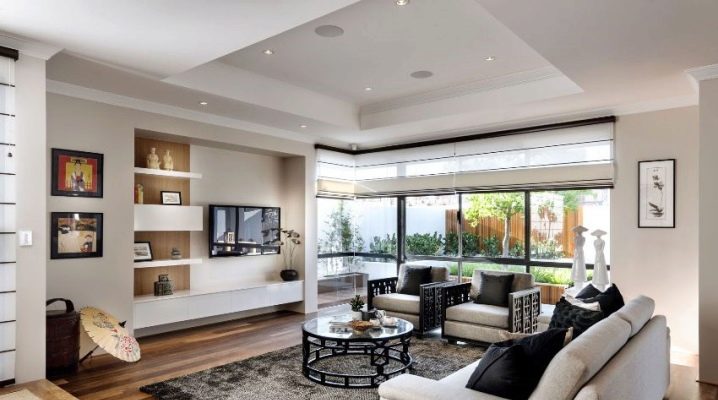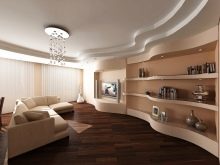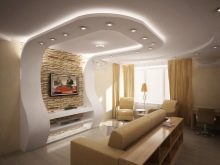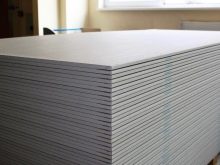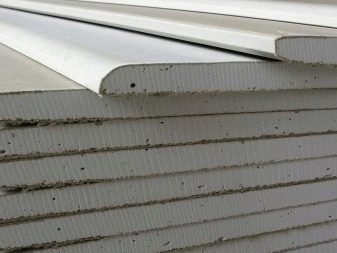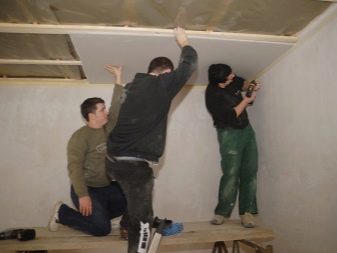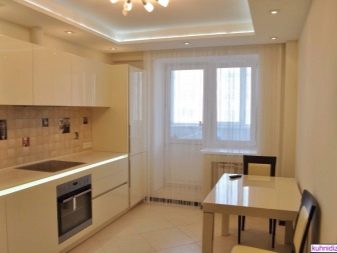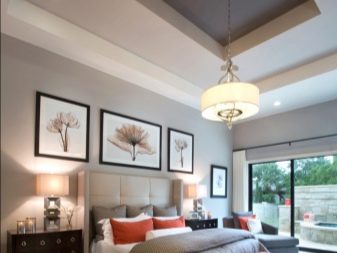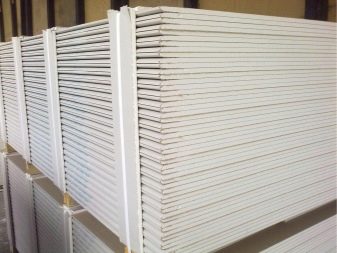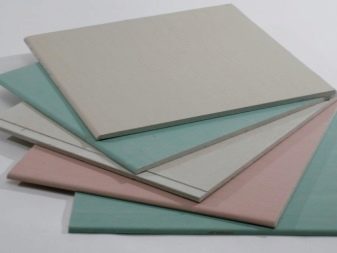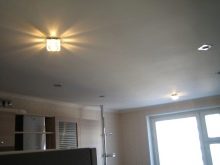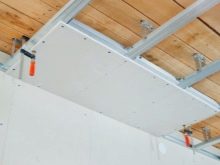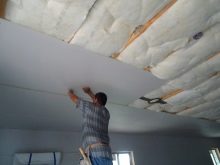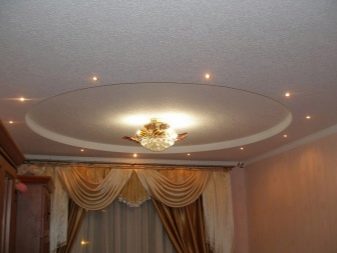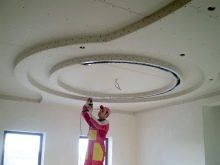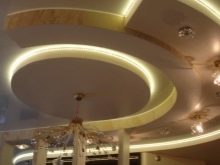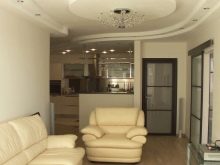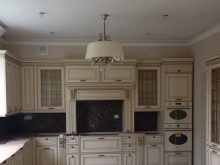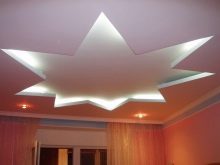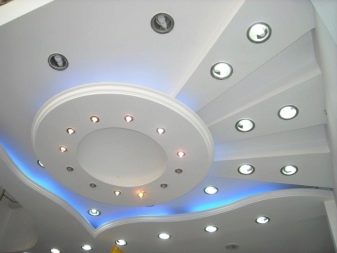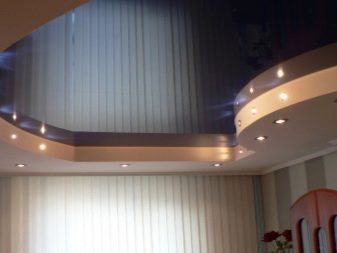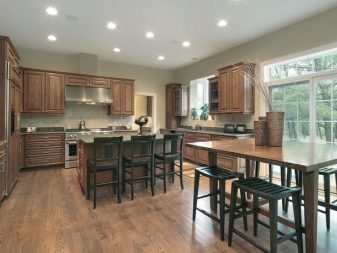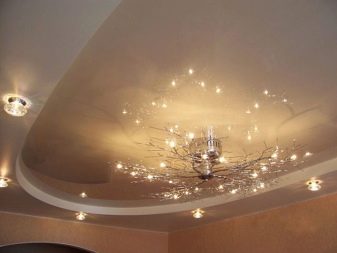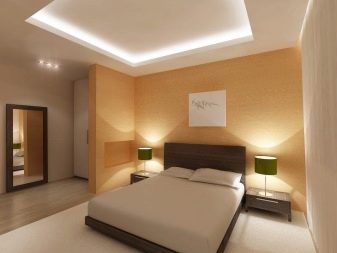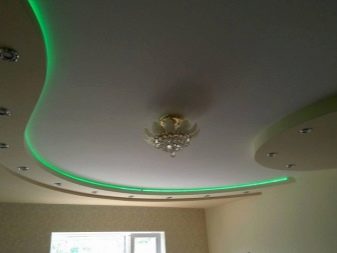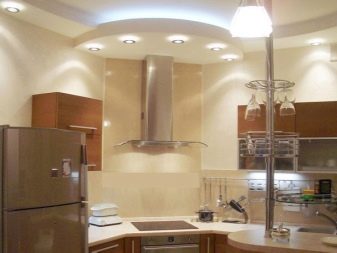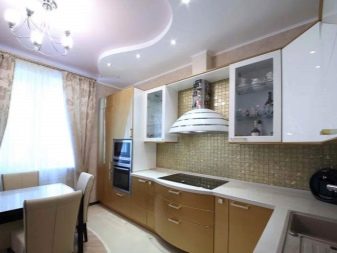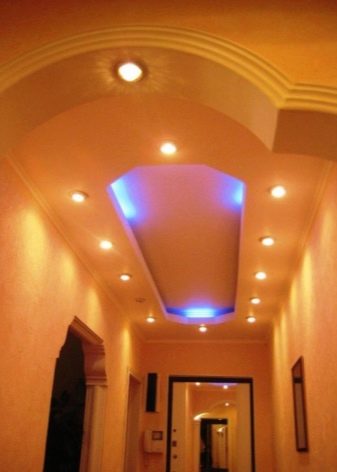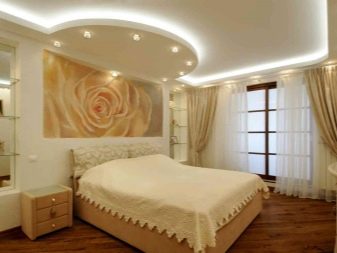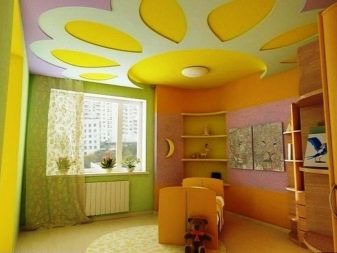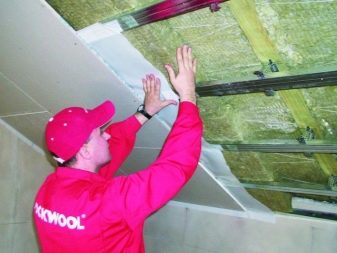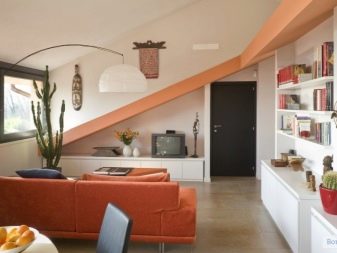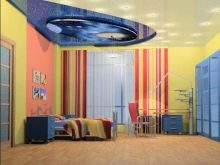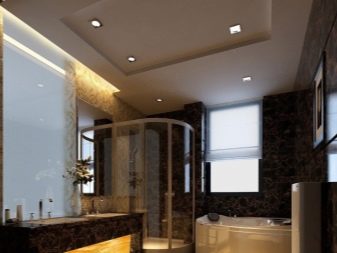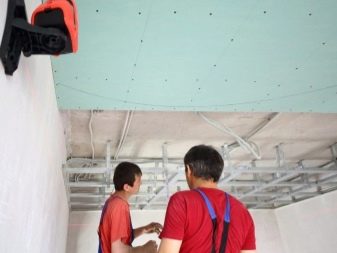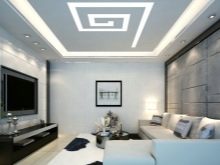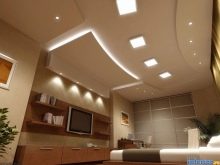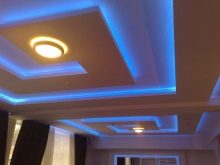The ceiling of the GCR: the pros and cons
When the question arises about the repair of the ceiling, not everyone knows what means it is better to use. There are three main ways to make the surface smooth and beautiful: level with plaster, stretch the film (stretch ceiling), carry out the installation of gypsum boards. This article will tell about the last method.
Special features
Designers often use drywall, because with it you can create the most bizarre shapes and volumes. This material is also suitable for classic lovers who like simple ideally even ceilings. Coverage also solves the problem of masking various communications.
To understand what constitutes this mysterious material, you only need to carefully read the title.This is gypsum, which is pasted over with sheets of cardboard on both sides. It is with this that its advantages and disadvantages are connected.
Gypsum is a rather fragile material. When working with it is important to observe certain precautions. It can not be put on the edge, and if it falls, then, most likely, cracks and cracks can not be avoided. But the same property allows you to easily cut the sheets and create complex shapes. If such fragility is critical for you, then you should choose a more durable analogue GCR called gypsum-fiber sheet (GVL).
Speaking on the construction language, this material is intended for "dry" interior decoration. i.e. for its installation neither special mixes, nor glue, nor concrete are required. Although in the raw form sheets do not leave. They are ground, puttied for painting or wallpaper.
Manufacturers produce drywall sheets of different thickness. The best option for the ceiling are sheets of 9 - 9.5 mm, for the walls choose a more dense KGL - from 12 mm.
Kinds
The classification of gypsum ceilings is carried out according to two criteria: by technical properties and by the number of levels. The first moment allows you to figure out what material is suitable for solving your problems.The second shows how many different solutions can be found using KGL for ceiling decoration.
According to the technical characteristics, there are 4 types of drywall:
- GKL - gypsum plasterboard. This is the easiest and most popular material. He is considered the most budget.
- GKLV - gypsum plasterboard moisture resistant. It is more resistant to moisture, but do not think that it can be safely used in damp and poorly ventilated areas. With constant contact with water and steam, it can quickly deform and become unusable.
- GKLO - gypsum plasterboard sheet. It finds its application in various rooms where an increased level of protection against fire is required. The main groups include industrial premises, places with a massive gathering of people, wooden houses, boilers, boiler rooms, game rooms. Material is available in gray and pink colors.
- GKLVO - gypsum plasterboard moisture resistant fireproof. As the name implies, this species combines all the positive properties of the two previous brethren. With a lot of advantages, he has one significant disadvantage - the high cost.Therefore, in residential premises this material is used extremely rarely. The main scope of its application is production and storage facilities, where there is a high level of humidity and compliance with fire safety requirements is required.
By the number of levels there are 3 types of gypsum ceilings.
Single level
They are a perfectly flat surface, suitable for lovers of classic and minimalism. It is rather difficult to distinguish a construction from a usual plastered ceiling. The advantage of this method is the ability to create different scenarios for lighting and masking communications behind GCR sheets. Due to the illumination of different parts of the room, the necessary effects are created, and the space is zoning.
Such a structure can be fixed in two ways: on special aluminum rails or directly to the ceiling. The second method is valid when the overlap is made of planks or beams and does not have serious flaws and projections. The second name of such a ceiling is “hemmed in”, because it is hemmed directly onto the existing old floor.
Duplex
This is a more complex modification of the suspended plasterboard ceiling.There are a lot of design options. This is the construction of an additional frame along the perimeter, and the selection of the central part with a chandelier, and all sorts of smooth curved or broken lines that differ in height.
An important aspect here is the ceiling height. The first level will “eat” 5-7 cm, the second will be even lower by 5-10 cm. If you have high ceilings, like in old “Stalinist” houses, or the room has impressive dimensions, then you can easily install a two-level suspended ceiling. In other cases, it is better to consult with the designer or choose a different coverage option.
Multilevel
For those who are not used to content with standard solutions, designers can offer unimaginable layouts with several levels. Sometimes it is not enough to solve certain design or technical tasks of 2 levels. Then constructions having a more complex configuration are constructed. It is very difficult to carry out such installation yourself; it requires professional knowledge and skills.
With the help of drywall, you can create any complex composition. But it is worth considering that the smaller the size of the room,the simpler the design should be. Otherwise, the construction of multi-level structures will make it heavier and visually reduce an already small room.
Design
List all possible forms of gypsum ceilings impossible. The flight of fantasy of designers and customers creates such fancy patterns and decorations that they simply cannot be systematized.
There are several main areas that are relevant today:
- Classic. These are single-level or simple two-level ceilings, the geometry of which is subject to traditional canons. The classics are the correct lines, the restrained color scale and any "shouting" details.
- Patterned. The shape and lines can be created both at the expense of different colors or finishing materials, and at the expense of levels. Such options are great for zoning space. Patterns can be used for decorative purposes. A flower, a butterfly or a floating bird can refresh any interior and create a romantic mood.
- Figured. If you want to change the geometry of space, this can be facilitated by the creation of various geometric shapes on the ceiling. Do not get carried away, more - does not mean better.
Recreate (or ask the designer) in the program for 3D modeling the final result. Perhaps you will reject it at the project stage.
- With spotlights. A variety of forms and models allow you to create stylish interiors and provide uniform lighting throughout the room. The main advantage of point lights - they do not overload the space. During the day they are practically invisible, and in the dark, they create a soft enveloping light.
How many of them will be on your ceiling, it's up to you. You can make the highlight of one particular zone, evenly distribute the lamps over the entire surface or arrange them around a traditional chandelier.
- LED backlit. Such lighting can be installed even on a single-level ceiling. One option is to hide the backlight above the baseboard. The soaring ceiling is created in this way. The same technique allows you to visually increase the space, make the ceilings higher.
For different rooms
The choice of a specific ceiling model depends on the purpose of the room, its style and area. Although there are universal options in the form of a single-level or two-level ceiling with a frame, which are suitable for the hallway, and for the bedroom.
- Kitchen. When arranging the ceiling in the kitchen is important to take care of a good hood. If the structure will constantly get steam, it can be deformed. To some extent, moisture-resistant drywall can solve the problem, but it will not last long with constant contact with hot steam.
As for the design, it can be a good solution. You can highlight the dining and work area. Here you can "play" with the form, but the drawings are best left for the nursery.
- The entrance hall. Often there are no windows in the corridor, so the problem of lighting here is particularly acute. If you use only one light bulb in the hallway, as provided for in most typical apartments, then even a small room will look visually smaller and “sullen”.
Place mirrors on the walls, they will reflect light and visually expand the space. Place the spotlights on the plasterboard ceiling around the perimeter. In this case, you can do without a central lighting device.
- Room. It is inexpedient to advise a certain design or shape of the ceiling for a room, since each has its own concepts of comfort, beauty and style.It is only necessary to note that this material is ideal both for the nursery and for the bedroom, since it is absolutely non-toxic and capable of passing air. If suddenly you do not like the shade, you can easily repaint the coating.
- Attic and basement. The use of drywall in such rooms can be complicated by high humidity. You can solve the problem, if you use an improved form of KGL (GFL). Due to certain additives it is more resistant to moisture. Also a problem can be solved by good thermal insulation and an enhanced ventilation system.
Tips and tricks
Some tips on using a gypsum ceiling:
- Do not be afraid to set up experiments in your own apartment. If you chose drywall as a ceiling material, then try to find a form that will emphasize all the advantages and hide all the disadvantages of the room.
- Remember that to install alone such a ceiling is almost impossible. At the very least, you will need the help of a friend who will hold and feed the right tools. They, by the way, also have to purchase.
- The thickness of the plasterboard for the ceiling should be 9.5 mm.This size is optimal (fairly light sheets that can withstand the corresponding loads).
- Drywall is a fragile material. Do not put it on the edge and do not drop it. Material should also be stored horizontally.
- Choose drywall based on the characteristics of the room. For the living room with a fireplace, a fireproof version is necessary, for the bathroom - moisture resistant.
- Do not use drywall in the new building in the first 2 years of operation. After the house shrinks, the plates may move, leading to cracks in the floor.
- If it is planned to carry out various communications (pipes from exhaust hoods, cables, etc.), hide them behind the ceiling before installation. This may be an additional box or the second level.
Beautiful examples in the interior
There are many successful examples of design gypsum ceilings. You can completely repeat your favorite design or use it as a source for inspiration. What it will be - with clear geometric shapes, with a floral ornament, multilevel with a complex composition or elegantly turning into an arch - it's up to you to decide.Here are just a few beautiful examples showing how drywall can become in the skilled hands of a master.
To learn how to install a two-level plasterboard ceiling in the kitchen, see the following video.
